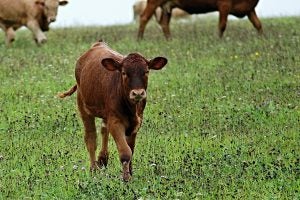Fall calving is mixed with fall harvest in my part of the United States. In my marriage there is a farmer and a rancher. Matt is the farmer. I’m the rancher. We both help wherever needed, but his passion is equipment and crops, mine is the cows. It works out because while he’s focusing on getting the crops in, I’m equally focused on a successful calving season.
Here’s my top 5 tips to make fall calving successful — because we all know it can turn into a train wreck if you’re not careful:
1. Preparation is key
Where are the cows going to calve at? Are you separating the pairs once the babies come along? Do you have facilities at the location or are they being trailered somewhere when a problem arises? Is your four-wheeler, utility vehicle, or horse prepared for the season?

2. Paperwork
Every operation has a different system that works for them. I have a list with all the cows on it. I have a column for the cow’s number, cow description, preg check, date of birth for calf, calf description, whether baby got tagged or not and a note column. This is an easy way to keep track of who has calved and who hasn’t. I have a separate page that is similar to my summer pasture lists. That way I can check them off regularly so I know they’re all there. Once they are moved to the pair pasture, they are highlighted on my list. It’s an easy way to keep track of where everybody is. These lists are kept in my pickup so they are easily available at the pasture.
3. Feed/supplementation
Whenever the first calf hits the ground, I stop driving the pickup in the pasture. I just stress about running over a baby in the grass. We utilize protein tubs in addition to their regular mineral. In Kansas, where I am, these fall cows are having the biggest pull on them as the grass is drying up and heading in to winter. I’ve found it’s easier to keep their condition solid, than trying to improve it once we hit winter. I try my best to make their lives as easy as it can be. I keep the flies knocked off them so they aren’t wasting energy fighting flies. Keeping their nutritional needs front of mind right now is important to solving a lot of the winter weak cow issues. It’s the old saying, an ounce of prevention is worth a pound of cure. Doing a little extra nutritionally now is better than fighting all winter to get them back in shape as they’re growing calves and rebreeding.

4. Calving paraphernalia
Do you have all the equipment gathered you need? Several years ago, my husband Matt’s Aunt Kay told us she carried an old purse with everything she needed. I adapted that to a backpack. It has all the essentials: tags, marker, tagger, chains, triangles for chains, gloves, lubrication, baby powder, rags and binoculars. I never know what I’m going to be taking to the pasture from the harvest field, but having everything I need in an easy to grab backpack ensures I don’t fall behind tagging because I don’t have what I need. Also, if there is any trouble, I have everything I need to fix it.
5. Adoption
My FFA Advisor from high school always comments that he wants a 100 percent calving season — no lost babies. In the meantime until we can accomplish that, what’s the plan for lost babies? In our herd, unless the cow is in very poor health or I absolutely cannot find a baby, she is given the chance to adopt. Knock on wood, but I have a 100 percent success rate for adoptions. I feel confident buying a calf to put on a cow without the fear of having a bottle baby if she rejects it. Our neighbor, Brad, told me about the baby powder trick several years ago and since then we have a 100 percent track record.
Forget about the expensive calf adoption powders or rubbing the old baby on the new one or skinning or whatever else. Get yourself some baby powder. Put baby powder all over the new baby. Baby powder is cheap, don’t be afraid to put some on. Make a black calf look like a charolais. Really put it on. Then cover the cow’s face with it. Careful you don’t get it in her eyes or straight in her nostrils. It makes quite the cloud when you’re doing it. Keep them in a tight pen, as long as the cow isn’t going to hurt the baby, and watch the magic. Depending on the condition, most of the time — close to 100 percent of the time — we put the cow in the chute to nurse the first time. Then it depends on the cow. We’ve had them take them right away. Sometimes it takes three or four times in the chute, dousing with the powder each time. The longest I have worked with a cow is three weeks. The second longest was two weeks. The rest have all been well under a week. It requires patience. Again, as long as the cow is in good condition and isn’t crazy, my philosophy is we’ve fed her all year, a $200 to 300 calf is pretty cheap, especially if she’s young or in her prime. But I love my cows and prefer the ones I have than taming new ones down.
Whether you’re the cow lover or the crop lover that has cows on the side, may you have a great fall season. I hope harvest goes smoothly with few breakdowns. I hope you get your 100 percent fall calf crop! Stay safe, be careful and good luck!
Kelsey Pagel is a Kansas farmer. She grew up on a cow/calf and row crop operation and married into another. Kelsey and her Forever (Matt) farm and ranch with his family where they are living their dream and loving most of the moments.



